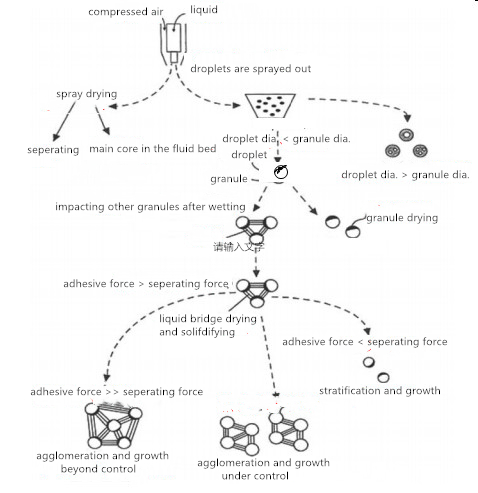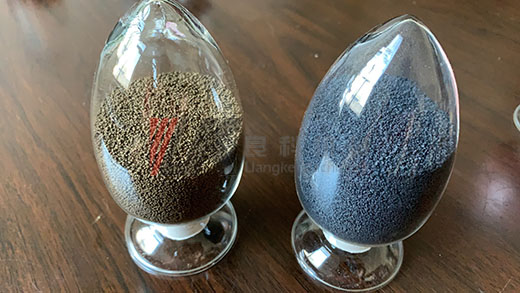Writer: admin Time:2020-11-25 17:24 Browse:℃
Technology of fluid bed started from 1942 but was not adopted in pharmaceutical industry at that time. Later Wuster released the first report on adoption of fluid bed in pharmaceutical industry to coat tablets. As technologies developed, Wunster started its application of fluid bed in one-step granulation from 1960.
1. Theories on fluid bed granulation
Fluid bed granulation is particularly suitable for material whose size ranges from 50μm to 200μm. The fluidization of granules is actually the result of joint forces between granules. The strong airflow can overcome granules’ gravity and thus fluidize them. low-speed input air blows the granules at the speed directly proportional to the pressure drop in fluid bed. As the air speed increases, granules turn to suspending. At this point, the air speed is called the minimum fluidizing velocity. This velocity is a primary lower limit of one-step granulation. As granulation goes on, the velocity increases gradually. But the fluidizing speed during granulation should be higher than this minimum speed so as to not separate fine granules from large granules.
When fluidizing speed is higher than the minimum fluidizing speed, the fluidized material moves like being boiled. There are foams forming under the fluid bed and near the airflow distribution board. The foams can ascend and then burst due to the function of air blower. It can be thus seen that airflow distribution board can have great influence on the fluid bed. And as fluidizing speed increases, the powder expands and granule density decreases in the unit volume. Furthermore, when the fluidizing speed reaches a certain speed, the granules will be blown away. The speed at this point is referred to as entrainment velocity. The granulating and mixing degree is related to granule size and movement of airflow through the material. And the movement of airflow can also influence heat exchange between air and granules.
The standard air input velocity is usually 1.0-2.0m/s. For agglomerated material, the airflow rate should be five or six times higher than the minimum fluidizing velocity. During drying, the airflow rate should keep relatively low, ranging from 0.8m/s to 1.4m/s. Even though wet material in the fluid bed demands high airflow rate at the beginning of drying, the air speed should be slowed down after the products are dehydrated to guarantee granules’ normal motion and prevent material from entering the filter. Granule motion and quick drying together play an important roll in fluid bed granulation. The good granulating state is that the granules move down freely. The fluidizing state can also be monitored depending on the exhausted air temperature. Different product has its own proper drying speed. The temperature inside the fluid bed should keep constant for a pretty long time. Therefore, if the temperature of exhausted air rises more quickly than expected, the fluidization is not so good that granulation should be stopped and some manual or mechanical measures can be taken to facilitate fluidizing.
2. Principle on granule agglomeration and growth
Agglomeration is the process during which fine granules grow and obtain larger size. There are three principles to explain agglomeration:
1) The immobile liquid on the granule surface forms cohesive bridge for fine granules’ cohesion;
2) The surface force and capillary force compact granules;
3) The material once dissolved in a solvent crystallizes and forms solid bridge.
Ideally, the primary granules contact with moisturizer droplets while passing through the spraying area in the fluid bed. The moisturizer spreads on the granule surface and wets the granules. At the same time, granules compact to form liquid bridge. Then the granules are dried and solidified to larger granules. The granulating principle of fluid bed is as follows:


| Technical parameters | Influence |
| Input air temperature | High temperature leads to fine granules while low temperature leads to hard granules. |
| Humidity | Increasing humidity will cause larger granules and longer drying time. |
| Fluidizing air | Proper airflow can fluidize material without clogging the filter, while higher air speed perhaps causes material loss, quick evaporation and fine granules or powder. |
| Spray gun position | The spray gun should primarily function to generate fine droplets of the solution except adhesive. Size of adhesive droplets is not so influential. Besides, it’s better to install the spray gun at the position where it can cover the fluid bed. Its being too close to the material will wet material quickly so that large granules are produced. On the contrary, if the spray gun is too high, the droplets will dry quickly and fine granules are produced so that the time for granulation is extended. |
| Atomizing airflow and pressure | The liquid is atomized by the compressed air. The ratio of solute against solvent should keep constant. Granule size can be controlled by controlling the droplet size. High liquid speed will cause larger droplets and granules and low speed causes small granules. Under the certain pressure, the larger the hole diameter is, the larger the droplet will be. |
| Adhesive spraying speed | Droplet size is influenced by liquid speed, adhesive viscosity and pressure and volume or atomizing air. The smaller droplets can lead to smaller granules. |
Tel: +86 731 84325468
Phone: +86 13787413551
Email: ava@lkpharmamachinery.com
Whatsapp: +86 13787413551(Ms. Ava)
Add: Ruian city, Zhejiang province